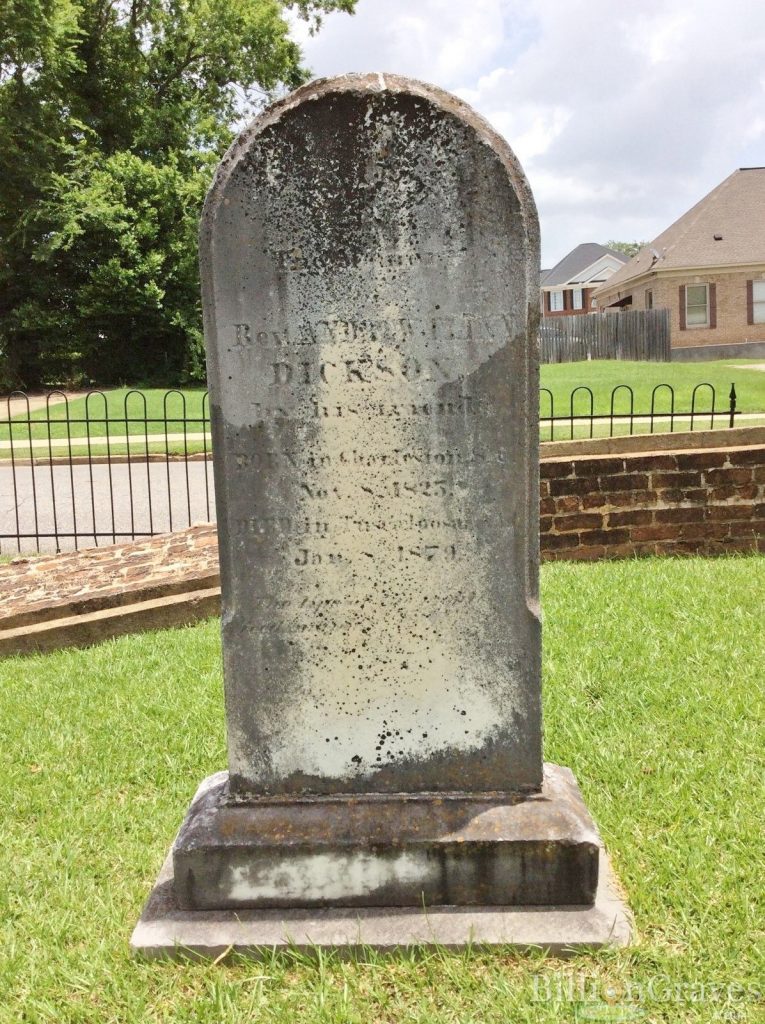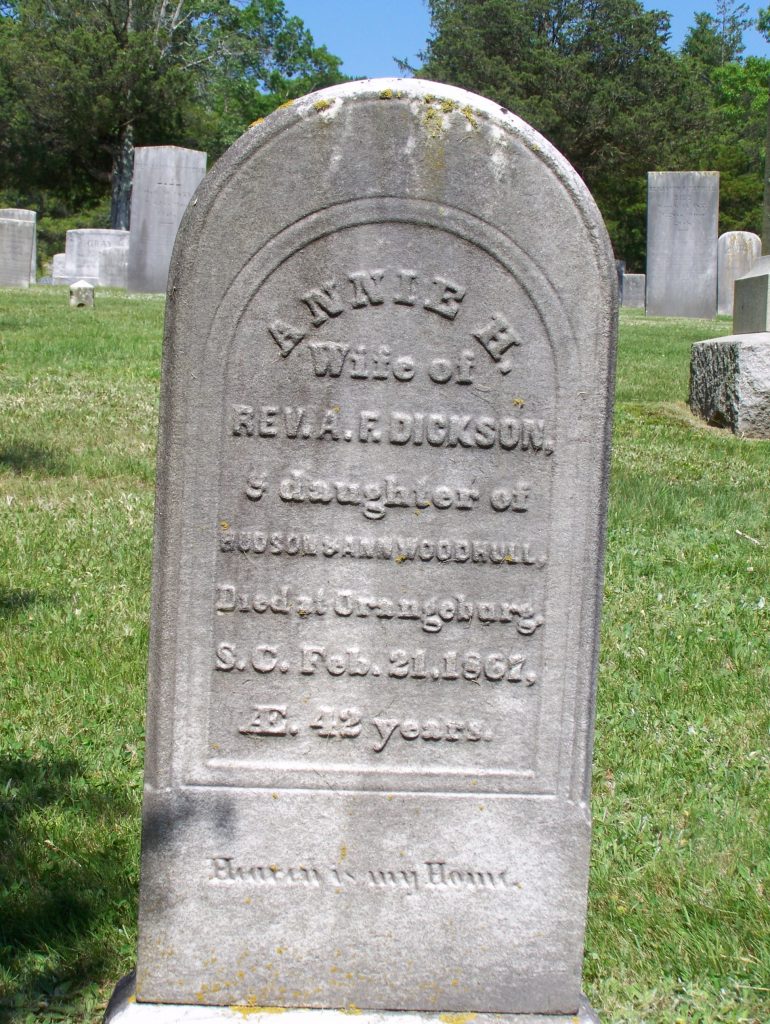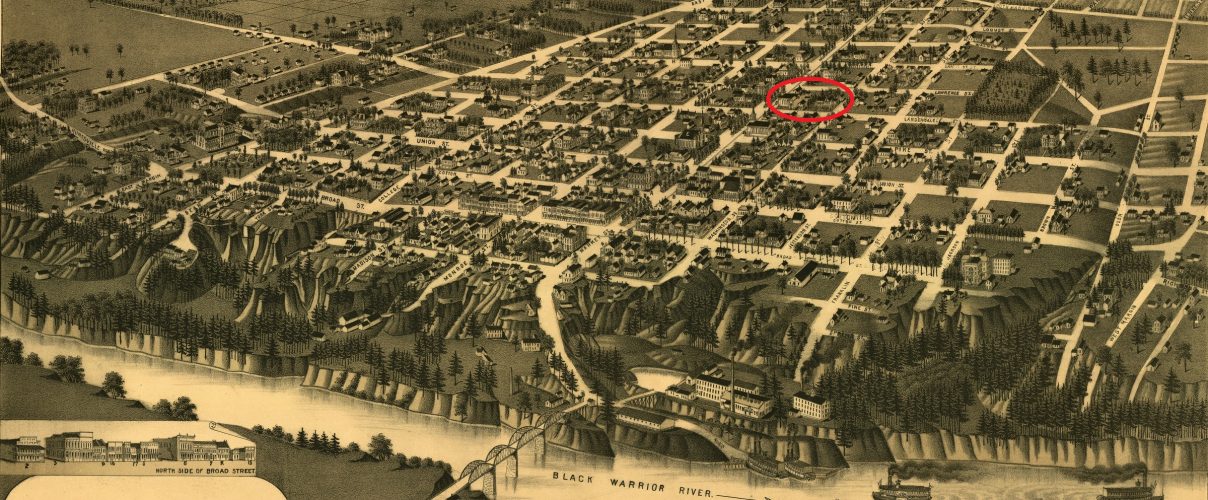 Andrew Flinn was born to Rev. John Augustus and Mary Augusta (Flinn) Dickson in Charleston, South Carolina, November 8, 1825. His mother was the daughter of the first pastor of Second Presbyterian Church, Andrew Flinn. The baby’s father was a graduate of Yale and he taught languages and moral philosophy in the College of Charleston. As Andrew matured he was influenced by both the atmosphere of learning and theological environment that nourished his great appetite for study and reading. About 1836, due to personal health problems, John relocated the family to Asheville, North Carolina, and started an academy for young ladies in his home which grew into a two-story school with its own property. John was also a part-time assistant pastor of First Presbyterian Church. Andrew grew up gaining ministerial understanding by observing how his father handled challenges coming from his educational and pastoral work. One difficulty in the Asheville church was not a common one. When the Presbyterian Church in the United States of America (PCUSA) divided into Old and New Schools in 1837, the Asheville church likewise divided almost right down the middle, half Old School and half New School. Following the division a church member built a nice new building that was used by both groups for services. Sharing by the two groups must have presented Rev. Dickson with some issues to resolve. Dr. John A. Dickson died in 1847 and was buried under the church annex.
Andrew Flinn was born to Rev. John Augustus and Mary Augusta (Flinn) Dickson in Charleston, South Carolina, November 8, 1825. His mother was the daughter of the first pastor of Second Presbyterian Church, Andrew Flinn. The baby’s father was a graduate of Yale and he taught languages and moral philosophy in the College of Charleston. As Andrew matured he was influenced by both the atmosphere of learning and theological environment that nourished his great appetite for study and reading. About 1836, due to personal health problems, John relocated the family to Asheville, North Carolina, and started an academy for young ladies in his home which grew into a two-story school with its own property. John was also a part-time assistant pastor of First Presbyterian Church. Andrew grew up gaining ministerial understanding by observing how his father handled challenges coming from his educational and pastoral work. One difficulty in the Asheville church was not a common one. When the Presbyterian Church in the United States of America (PCUSA) divided into Old and New Schools in 1837, the Asheville church likewise divided almost right down the middle, half Old School and half New School. Following the division a church member built a nice new building that was used by both groups for services. Sharing by the two groups must have presented Rev. Dickson with some issues to resolve. Dr. John A. Dickson died in 1847 and was buried under the church annex.
Following his preparatory education in a local academy, Andrew F. Dickson entered Yale University with its junior class and after graduation in 1845 he went to Cincinnati to teach school and then study divinity in Lane Theological Seminary. At the time, the president of Lane was Harriet Beecher Stowe’s father, Dr. Lyman Beecher. For reasons unknown, Andrew did not take to Lane and left after just a few months to return to familiar New Haven and complete his ministerial preparation in Yale Divinity School in 1850. During his studies he was licensed to preach by the Middlesex Association of Congregational Ministers, August 6, 1849. Dickson married Annie H. Woodhull of Wading River, Long Island, on January 7, 1850. When his program in New Haven was completed he returned to the Lowcountry to be ordained and installed by Charleston Union Presbytery, Old School, in the John’s Island Church in 1850. Dickson continued ministry on the island for about five years and then became district secretary of the American Sunday School Union for a term of about two years. In 1857 he moved the household to Orangeburg where at first he supplied the Presbyterian Church’s pulpit but was then installed the pastor on May 13, 1860. When the Civil War began, he took a leave of absence to serve in the chaplaincy for the Confederacy. Dickson returned to Orangeburg and continued his ministry after the war ended. The years 1866-1867 were particularly tough on his household due to the post-war economic situation in South Carolina, severe flooding followed by drought, the death of his wife in February, and the loss of his home because of a fire. During the tough times Pastor Dickson received food and supplies from Philadelphia, Baltimore, and Louisville which he distributed to his congregation and neighbors in need. The household left Orangeburg in 1869 so Dickson could accept a call in New Orleans to Fourth Presbyterian Church (became Canal Street Presbyterian Church). Dickson left Louisiana after about three years. Following a brief pastorate in Wilmington, North Carolina, he returned to South Carolina to shepherd the Purity Presbyterian Church in Chester.

Dickson had spent his life for the most part in pulpit ministry, but his next opportunity transitioned him into educational work. In 1876, the Presbyterian Church in the United States (PCUS) began the “Institute for the Education of Coloured Ministers” in Tuscaloosa, Alabama. Charles A. Stillman had been appointed its superintendent but he could not take on all the responsibilities required to operate the school due to his already full schedule. Stillman was the minister of First Presbyterian Church in Tuscaloosa, stated clerk of his presbytery, and selected by the general assembly to direct fund raising for the ministerial training institute. Dickson taught in the institute for just a short time because in December 1878 he contracted pleurisy and passed away January 9 the next year. He was buried in Greenwood Cemetery in Tuscaloosa. The institute in Tuscaloosa exists today as Stillman College.
Rev. Dickson was survived by his second wife M. Rees Lee of Sumter, South Carolina. The Dickson household had fourteen children over the years with ten surviving their father. His last child was a boy given the name Andrew Flinn Dickson, presumably, to honor his father. The infant was born six months after his father’s death. Included among his written works are two books of sermons coming out of his Lowcountry years of ministry—Plantation Sermons: or Plain and Familiar Discourses for the Unlearned, 1856, and Lessons About Salvation: From the Life and Words of the Lord Jesus, being a Second Series of Plantation Sermons. He also penned The Temptation in the Desert, 1860, Hazael; or Know Thyself, [1867], and he contributed to serials including Southern Presbyterian Review, Christian Intelligencer (New York), and the Southern Presbyterian.
Barry Waugh

Notes-The header image is snipped from an 1887 map of Tuscaloosa held by the Library of Congress; the red ellipse marks the block occupied by First Church. The portrait was kindly provided by a reader of Presbyterians of the Past. The grave site images are, first, Andrew Flinn Dickson, 1825-1879, by carolcg, on Billion Graves site; the second grave is Annie H. Woodhull Dickson, on Find a Grave, by Arleen Koello. John Augustus Dickson lived from 1795-1847. Information about Rev. J.A. Dickson and his work in Asheville was located in A Spire in the Mountains: The Story of 176 Years of a Church and a Town Growing Together, 1794-1969, by Ora Blackmun, published by First Presbyterian Church in 1970. Information about John Dickson’s work in Charleston is from A History of the College of Charleston, Founded 1770, by J. H. Easterby, 1935. An important source was Record of the Class of 1845 of Yale College, Containing Obituaries of Deceased and Biographical Sketches of Surviving Members, New York: Jenkins and Thomas, 1861, which includes some details about the lives and families of the Dickson children. Two obituary pieces about Dickson were provided by Wayne Sparkman of the PCA Historical Center from The Christian Observer, 58.4 (22 January 1879): 4.





